Holmes Institute HI6028 Taxation Law: Analyzing Complex Tax Scenarios
VerifiedAdded on 2022/11/11
|10
|2212
|65
Homework Assignment
AI Summary
This assignment delves into various aspects of Australian taxation law, addressing issues related to Capital Gains Tax (CGT), income from personal exertion, and assessable income. It analyzes scenarios involving Helen's business financing, Barbara's book writing venture, and Patrick's financial assistance to David. The assignment applies relevant sections of the Income Tax Assessment Acts of 1936 and 1997, along with case law such as Jones v Leeming and Commissioner of Taxation v McNeil, to determine the tax implications of each situation. Specifically, it examines the CGT consequences of selling collectibles, the classification of income from writing and selling a book, and the taxability of financial assistance and loan repayments. The analysis provides detailed conclusions on whether specific transactions are subject to CGT, qualify as income from personal exertion, or constitute taxable income.
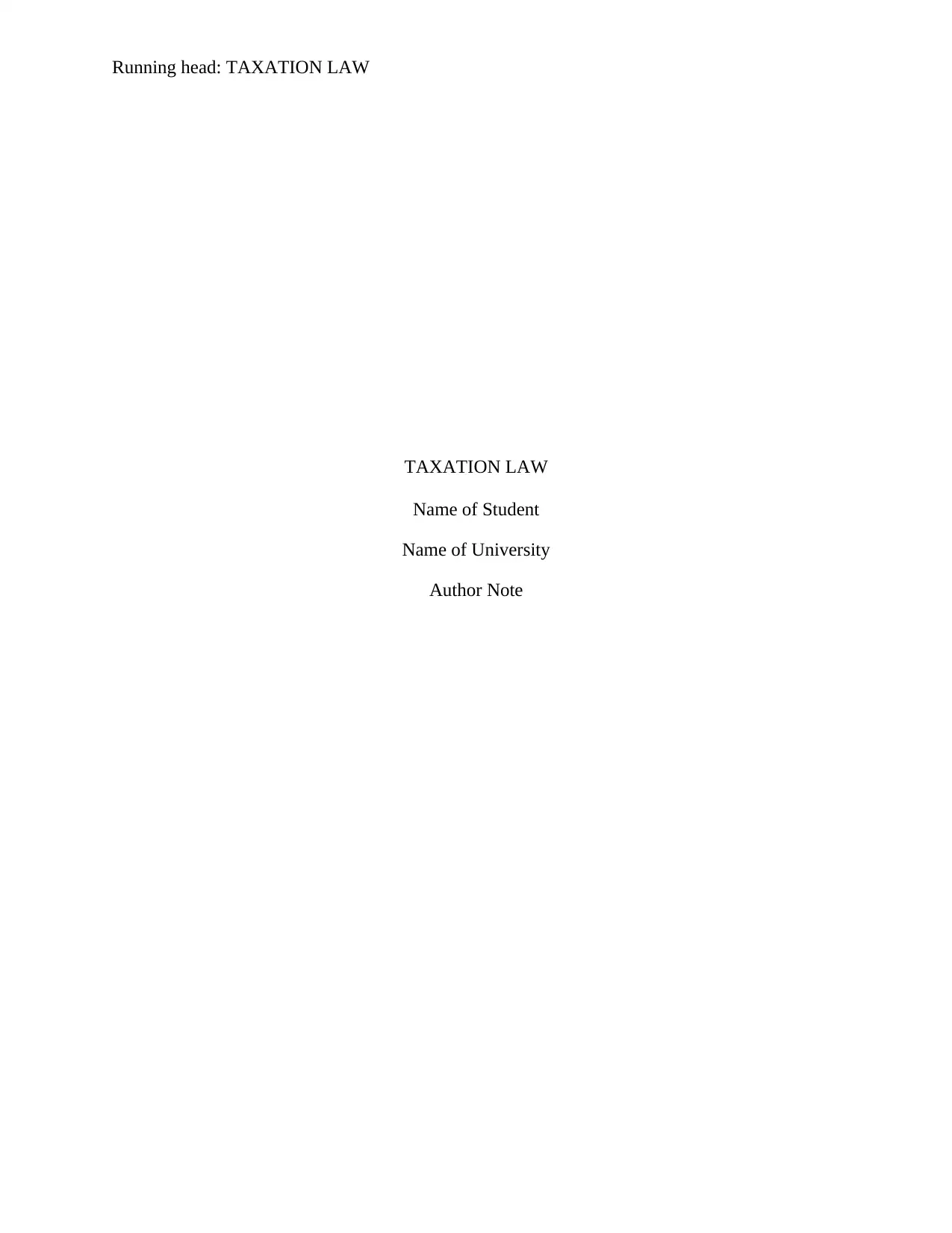
Running head: TAXATION LAW
TAXATION LAW
Name of Student
Name of University
Author Note
TAXATION LAW
Name of Student
Name of University
Author Note
Paraphrase This Document
Need a fresh take? Get an instant paraphrase of this document with our AI Paraphraser
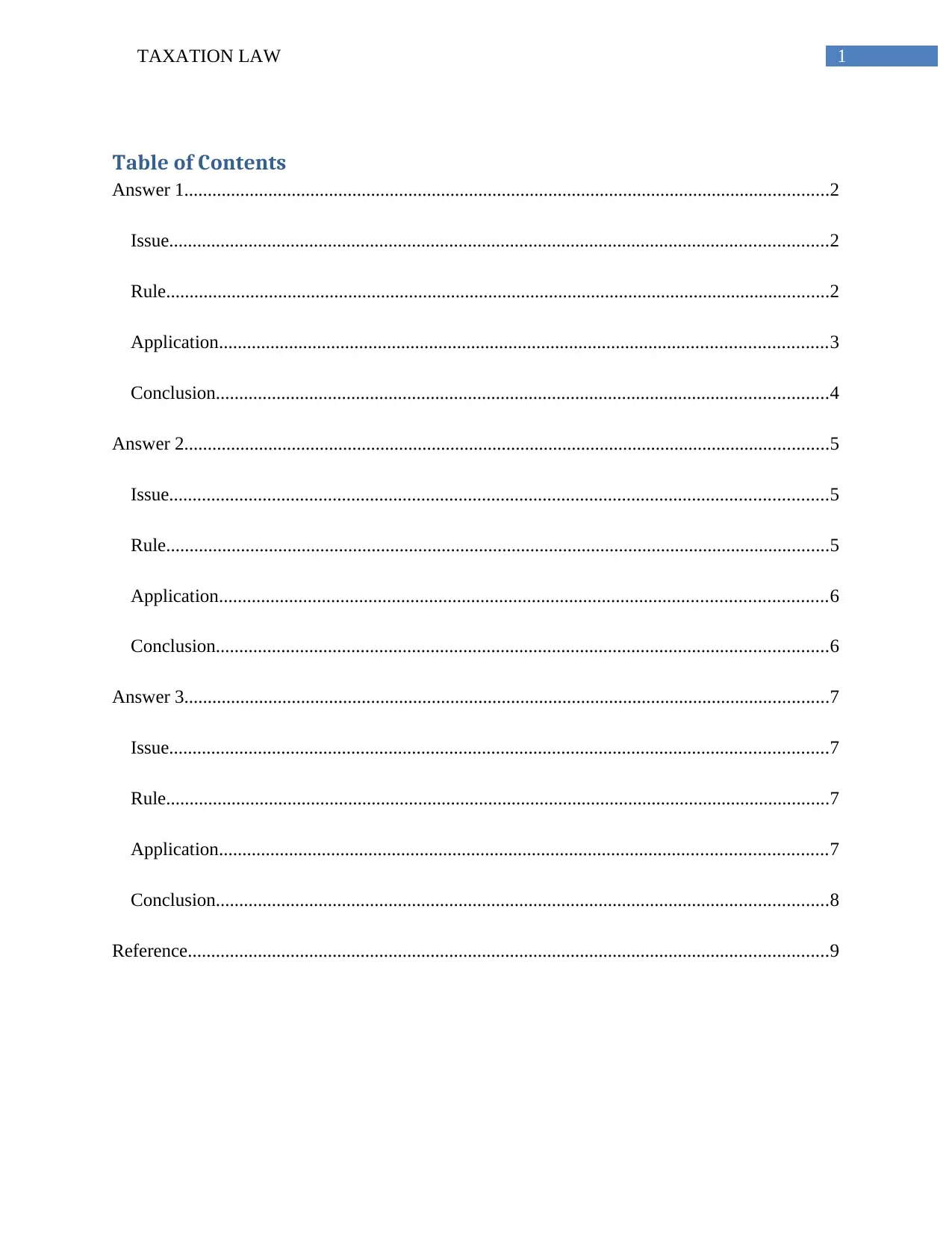
1TAXATION LAW
Table of Contents
Answer 1..........................................................................................................................................2
Issue.............................................................................................................................................2
Rule..............................................................................................................................................2
Application..................................................................................................................................3
Conclusion...................................................................................................................................4
Answer 2..........................................................................................................................................5
Issue.............................................................................................................................................5
Rule..............................................................................................................................................5
Application..................................................................................................................................6
Conclusion...................................................................................................................................6
Answer 3..........................................................................................................................................7
Issue.............................................................................................................................................7
Rule..............................................................................................................................................7
Application..................................................................................................................................7
Conclusion...................................................................................................................................8
Reference.........................................................................................................................................9
Table of Contents
Answer 1..........................................................................................................................................2
Issue.............................................................................................................................................2
Rule..............................................................................................................................................2
Application..................................................................................................................................3
Conclusion...................................................................................................................................4
Answer 2..........................................................................................................................................5
Issue.............................................................................................................................................5
Rule..............................................................................................................................................5
Application..................................................................................................................................6
Conclusion...................................................................................................................................6
Answer 3..........................................................................................................................................7
Issue.............................................................................................................................................7
Rule..............................................................................................................................................7
Application..................................................................................................................................7
Conclusion...................................................................................................................................8
Reference.........................................................................................................................................9
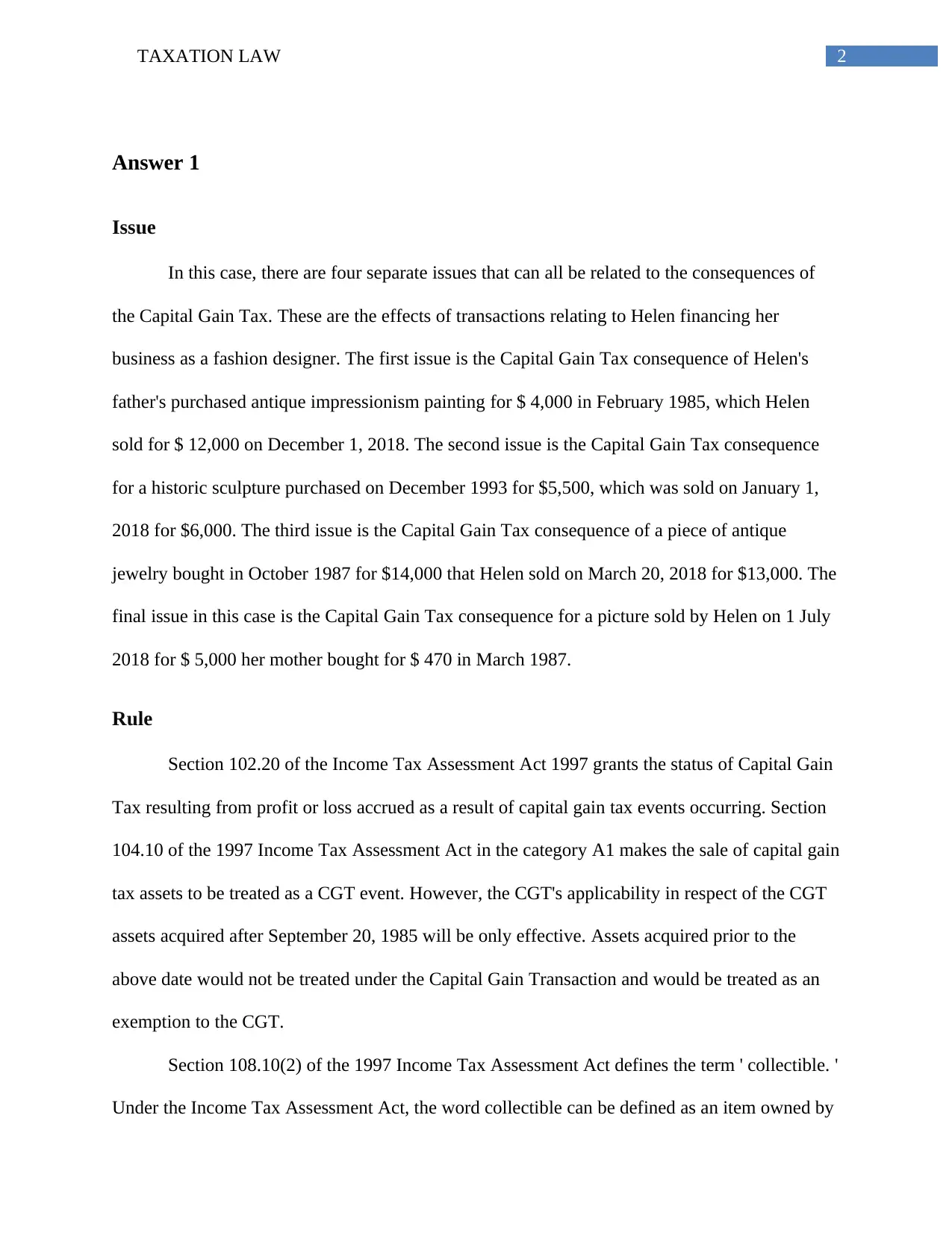
2TAXATION LAW
Answer 1
Issue
In this case, there are four separate issues that can all be related to the consequences of
the Capital Gain Tax. These are the effects of transactions relating to Helen financing her
business as a fashion designer. The first issue is the Capital Gain Tax consequence of Helen's
father's purchased antique impressionism painting for $ 4,000 in February 1985, which Helen
sold for $ 12,000 on December 1, 2018. The second issue is the Capital Gain Tax consequence
for a historic sculpture purchased on December 1993 for $5,500, which was sold on January 1,
2018 for $6,000. The third issue is the Capital Gain Tax consequence of a piece of antique
jewelry bought in October 1987 for $14,000 that Helen sold on March 20, 2018 for $13,000. The
final issue in this case is the Capital Gain Tax consequence for a picture sold by Helen on 1 July
2018 for $ 5,000 her mother bought for $ 470 in March 1987.
Rule
Section 102.20 of the Income Tax Assessment Act 1997 grants the status of Capital Gain
Tax resulting from profit or loss accrued as a result of capital gain tax events occurring. Section
104.10 of the 1997 Income Tax Assessment Act in the category A1 makes the sale of capital gain
tax assets to be treated as a CGT event. However, the CGT's applicability in respect of the CGT
assets acquired after September 20, 1985 will be only effective. Assets acquired prior to the
above date would not be treated under the Capital Gain Transaction and would be treated as an
exemption to the CGT.
Section 108.10(2) of the 1997 Income Tax Assessment Act defines the term ' collectible. '
Under the Income Tax Assessment Act, the word collectible can be defined as an item owned by
Answer 1
Issue
In this case, there are four separate issues that can all be related to the consequences of
the Capital Gain Tax. These are the effects of transactions relating to Helen financing her
business as a fashion designer. The first issue is the Capital Gain Tax consequence of Helen's
father's purchased antique impressionism painting for $ 4,000 in February 1985, which Helen
sold for $ 12,000 on December 1, 2018. The second issue is the Capital Gain Tax consequence
for a historic sculpture purchased on December 1993 for $5,500, which was sold on January 1,
2018 for $6,000. The third issue is the Capital Gain Tax consequence of a piece of antique
jewelry bought in October 1987 for $14,000 that Helen sold on March 20, 2018 for $13,000. The
final issue in this case is the Capital Gain Tax consequence for a picture sold by Helen on 1 July
2018 for $ 5,000 her mother bought for $ 470 in March 1987.
Rule
Section 102.20 of the Income Tax Assessment Act 1997 grants the status of Capital Gain
Tax resulting from profit or loss accrued as a result of capital gain tax events occurring. Section
104.10 of the 1997 Income Tax Assessment Act in the category A1 makes the sale of capital gain
tax assets to be treated as a CGT event. However, the CGT's applicability in respect of the CGT
assets acquired after September 20, 1985 will be only effective. Assets acquired prior to the
above date would not be treated under the Capital Gain Transaction and would be treated as an
exemption to the CGT.
Section 108.10(2) of the 1997 Income Tax Assessment Act defines the term ' collectible. '
Under the Income Tax Assessment Act, the word collectible can be defined as an item owned by
⊘ This is a preview!⊘
Do you want full access?
Subscribe today to unlock all pages.

Trusted by 1+ million students worldwide
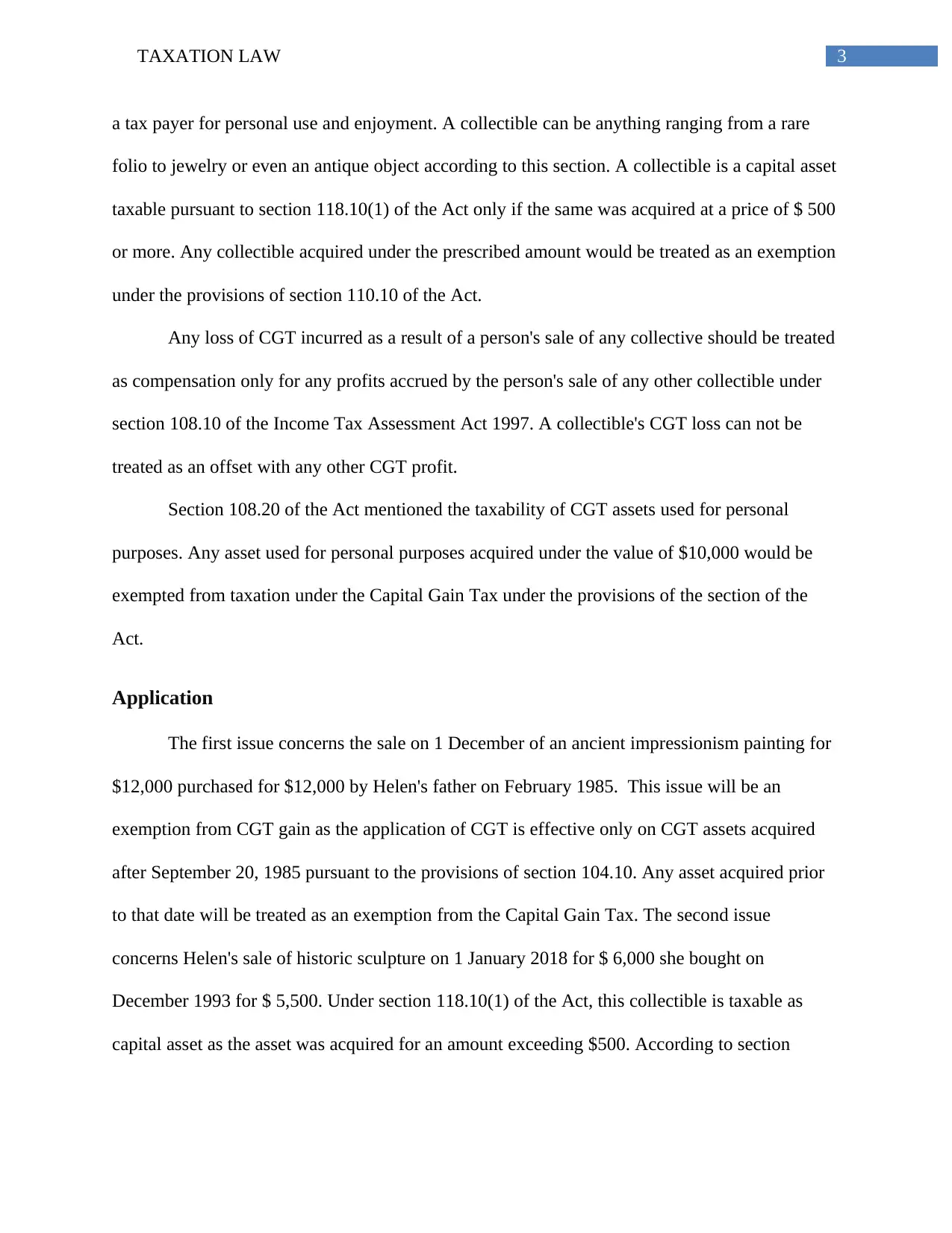
3TAXATION LAW
a tax payer for personal use and enjoyment. A collectible can be anything ranging from a rare
folio to jewelry or even an antique object according to this section. A collectible is a capital asset
taxable pursuant to section 118.10(1) of the Act only if the same was acquired at a price of $ 500
or more. Any collectible acquired under the prescribed amount would be treated as an exemption
under the provisions of section 110.10 of the Act.
Any loss of CGT incurred as a result of a person's sale of any collective should be treated
as compensation only for any profits accrued by the person's sale of any other collectible under
section 108.10 of the Income Tax Assessment Act 1997. A collectible's CGT loss can not be
treated as an offset with any other CGT profit.
Section 108.20 of the Act mentioned the taxability of CGT assets used for personal
purposes. Any asset used for personal purposes acquired under the value of $10,000 would be
exempted from taxation under the Capital Gain Tax under the provisions of the section of the
Act.
Application
The first issue concerns the sale on 1 December of an ancient impressionism painting for
$12,000 purchased for $12,000 by Helen's father on February 1985. This issue will be an
exemption from CGT gain as the application of CGT is effective only on CGT assets acquired
after September 20, 1985 pursuant to the provisions of section 104.10. Any asset acquired prior
to that date will be treated as an exemption from the Capital Gain Tax. The second issue
concerns Helen's sale of historic sculpture on 1 January 2018 for $ 6,000 she bought on
December 1993 for $ 5,500. Under section 118.10(1) of the Act, this collectible is taxable as
capital asset as the asset was acquired for an amount exceeding $500. According to section
a tax payer for personal use and enjoyment. A collectible can be anything ranging from a rare
folio to jewelry or even an antique object according to this section. A collectible is a capital asset
taxable pursuant to section 118.10(1) of the Act only if the same was acquired at a price of $ 500
or more. Any collectible acquired under the prescribed amount would be treated as an exemption
under the provisions of section 110.10 of the Act.
Any loss of CGT incurred as a result of a person's sale of any collective should be treated
as compensation only for any profits accrued by the person's sale of any other collectible under
section 108.10 of the Income Tax Assessment Act 1997. A collectible's CGT loss can not be
treated as an offset with any other CGT profit.
Section 108.20 of the Act mentioned the taxability of CGT assets used for personal
purposes. Any asset used for personal purposes acquired under the value of $10,000 would be
exempted from taxation under the Capital Gain Tax under the provisions of the section of the
Act.
Application
The first issue concerns the sale on 1 December of an ancient impressionism painting for
$12,000 purchased for $12,000 by Helen's father on February 1985. This issue will be an
exemption from CGT gain as the application of CGT is effective only on CGT assets acquired
after September 20, 1985 pursuant to the provisions of section 104.10. Any asset acquired prior
to that date will be treated as an exemption from the Capital Gain Tax. The second issue
concerns Helen's sale of historic sculpture on 1 January 2018 for $ 6,000 she bought on
December 1993 for $ 5,500. Under section 118.10(1) of the Act, this collectible is taxable as
capital asset as the asset was acquired for an amount exceeding $500. According to section
Paraphrase This Document
Need a fresh take? Get an instant paraphrase of this document with our AI Paraphraser

4TAXATION LAW
110.10 of the act ay collectible acquired under the prescribed amount will be considered an
exemption for the CGT.
Helen sold for $13,000, in the third issue, an antique jewelry on March 20, 2018 she had
bought for $14,000 on October 1987. This issue relates to section 108.10 of the Act, which
provides that only any CGT gain accrued by the sale of any other collectible will compensate for
a CGT loss incurred. This loss can not be treated as offset with any other CGT gain under the
provisions of this section. The CGT loss on jewelry sales would be treated as offset by the CGT
gain from the sale of the sculpture.
In the fourth issue it is seen that on 1 July 2018 Helen sold a picture purchased by Helen's
mother on March 1987 for $ 470 for $ 5,000. The picture will be treated as a personal-purpose
CGT asset. Under section 108.20 it will be treated as an exemption to CGT if the value of an
asset used for personal purposes does not exceed $ 10,000. Because the picture value is seen to
be less than $ 10,000, it would be considered as a CGT exemption.
Conclusion
It can be concluded that the sale of $12,000 of the ancient impressionism painting would
be considered a CGT gain exemption. Historical sculpture sales may be considered taxable as
capital assets. Further the sale of the antique jewellery needs to be treated as offset with CGT
gains accrued with respect to the sale of another collectible. Finally, the sale of the picture must
be treated as a CGT asset used for personal purposes and as the cost of the picture is less than $
10,000 it should be treated as a tax exemption under CGT.
110.10 of the act ay collectible acquired under the prescribed amount will be considered an
exemption for the CGT.
Helen sold for $13,000, in the third issue, an antique jewelry on March 20, 2018 she had
bought for $14,000 on October 1987. This issue relates to section 108.10 of the Act, which
provides that only any CGT gain accrued by the sale of any other collectible will compensate for
a CGT loss incurred. This loss can not be treated as offset with any other CGT gain under the
provisions of this section. The CGT loss on jewelry sales would be treated as offset by the CGT
gain from the sale of the sculpture.
In the fourth issue it is seen that on 1 July 2018 Helen sold a picture purchased by Helen's
mother on March 1987 for $ 470 for $ 5,000. The picture will be treated as a personal-purpose
CGT asset. Under section 108.20 it will be treated as an exemption to CGT if the value of an
asset used for personal purposes does not exceed $ 10,000. Because the picture value is seen to
be less than $ 10,000, it would be considered as a CGT exemption.
Conclusion
It can be concluded that the sale of $12,000 of the ancient impressionism painting would
be considered a CGT gain exemption. Historical sculpture sales may be considered taxable as
capital assets. Further the sale of the antique jewellery needs to be treated as offset with CGT
gains accrued with respect to the sale of another collectible. Finally, the sale of the picture must
be treated as a CGT asset used for personal purposes and as the cost of the picture is less than $
10,000 it should be treated as a tax exemption under CGT.
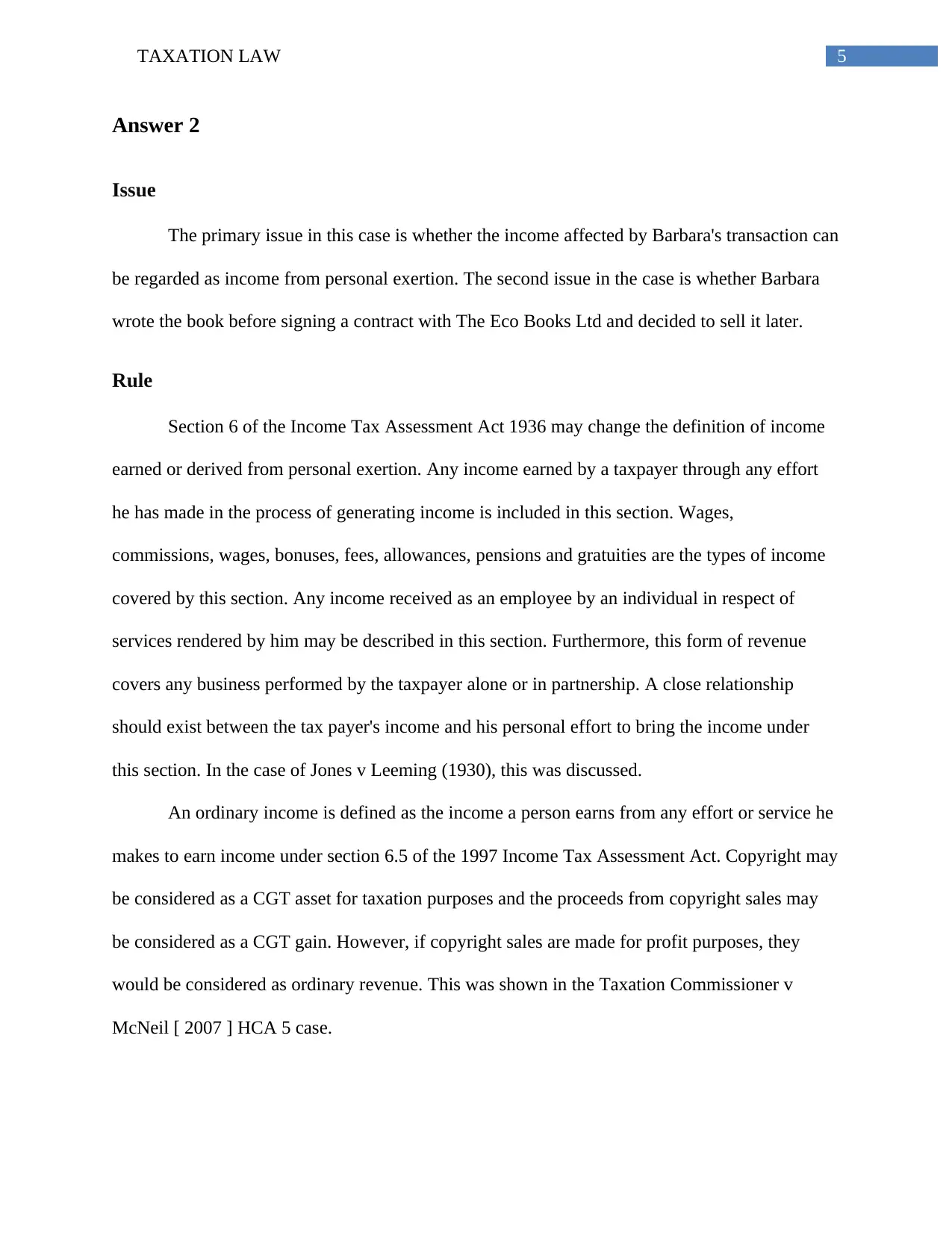
5TAXATION LAW
Answer 2
Issue
The primary issue in this case is whether the income affected by Barbara's transaction can
be regarded as income from personal exertion. The second issue in the case is whether Barbara
wrote the book before signing a contract with The Eco Books Ltd and decided to sell it later.
Rule
Section 6 of the Income Tax Assessment Act 1936 may change the definition of income
earned or derived from personal exertion. Any income earned by a taxpayer through any effort
he has made in the process of generating income is included in this section. Wages,
commissions, wages, bonuses, fees, allowances, pensions and gratuities are the types of income
covered by this section. Any income received as an employee by an individual in respect of
services rendered by him may be described in this section. Furthermore, this form of revenue
covers any business performed by the taxpayer alone or in partnership. A close relationship
should exist between the tax payer's income and his personal effort to bring the income under
this section. In the case of Jones v Leeming (1930), this was discussed.
An ordinary income is defined as the income a person earns from any effort or service he
makes to earn income under section 6.5 of the 1997 Income Tax Assessment Act. Copyright may
be considered as a CGT asset for taxation purposes and the proceeds from copyright sales may
be considered as a CGT gain. However, if copyright sales are made for profit purposes, they
would be considered as ordinary revenue. This was shown in the Taxation Commissioner v
McNeil [ 2007 ] HCA 5 case.
Answer 2
Issue
The primary issue in this case is whether the income affected by Barbara's transaction can
be regarded as income from personal exertion. The second issue in the case is whether Barbara
wrote the book before signing a contract with The Eco Books Ltd and decided to sell it later.
Rule
Section 6 of the Income Tax Assessment Act 1936 may change the definition of income
earned or derived from personal exertion. Any income earned by a taxpayer through any effort
he has made in the process of generating income is included in this section. Wages,
commissions, wages, bonuses, fees, allowances, pensions and gratuities are the types of income
covered by this section. Any income received as an employee by an individual in respect of
services rendered by him may be described in this section. Furthermore, this form of revenue
covers any business performed by the taxpayer alone or in partnership. A close relationship
should exist between the tax payer's income and his personal effort to bring the income under
this section. In the case of Jones v Leeming (1930), this was discussed.
An ordinary income is defined as the income a person earns from any effort or service he
makes to earn income under section 6.5 of the 1997 Income Tax Assessment Act. Copyright may
be considered as a CGT asset for taxation purposes and the proceeds from copyright sales may
be considered as a CGT gain. However, if copyright sales are made for profit purposes, they
would be considered as ordinary revenue. This was shown in the Taxation Commissioner v
McNeil [ 2007 ] HCA 5 case.
⊘ This is a preview!⊘
Do you want full access?
Subscribe today to unlock all pages.

Trusted by 1+ million students worldwide
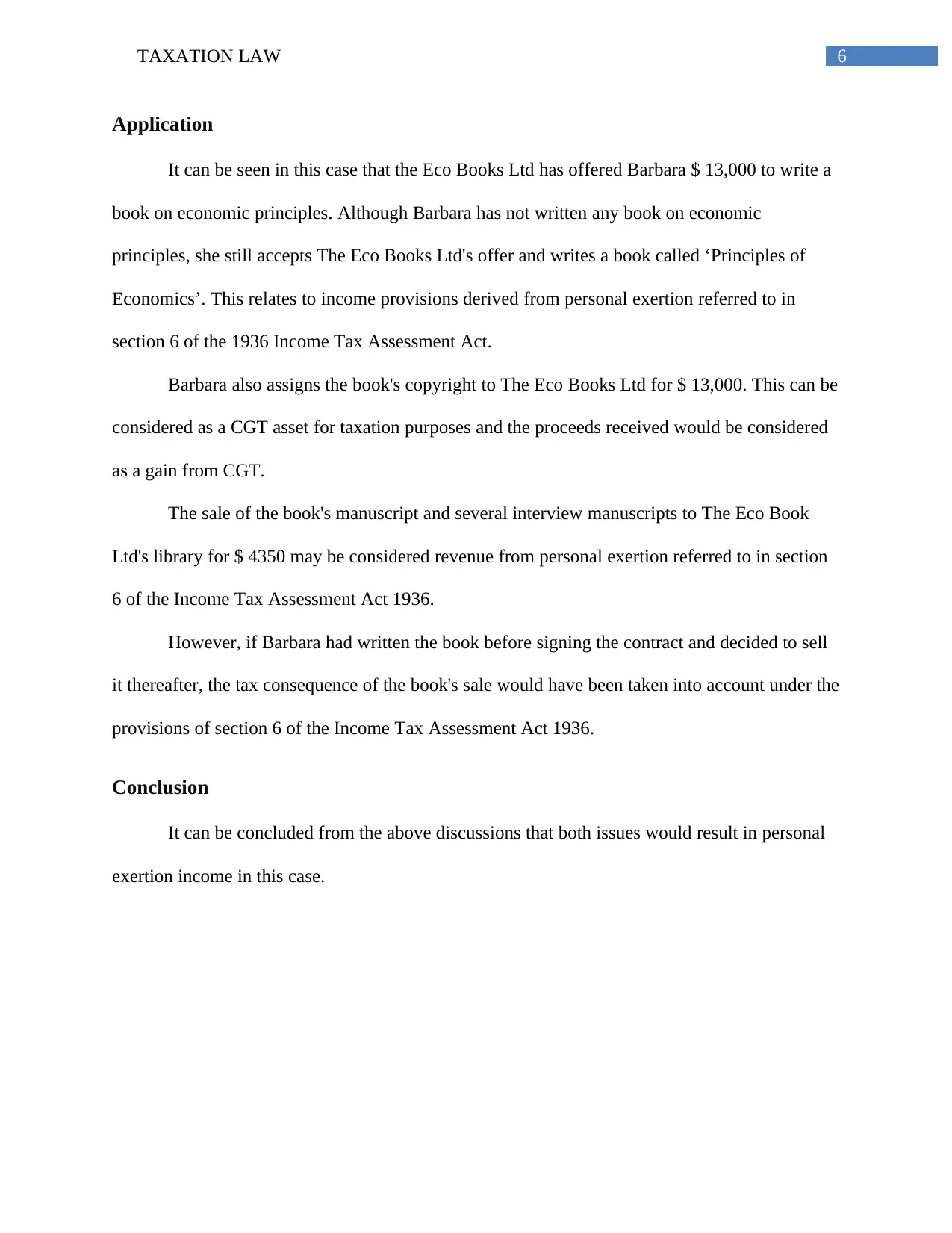
6TAXATION LAW
Application
It can be seen in this case that the Eco Books Ltd has offered Barbara $ 13,000 to write a
book on economic principles. Although Barbara has not written any book on economic
principles, she still accepts The Eco Books Ltd's offer and writes a book called ‘Principles of
Economics’. This relates to income provisions derived from personal exertion referred to in
section 6 of the 1936 Income Tax Assessment Act.
Barbara also assigns the book's copyright to The Eco Books Ltd for $ 13,000. This can be
considered as a CGT asset for taxation purposes and the proceeds received would be considered
as a gain from CGT.
The sale of the book's manuscript and several interview manuscripts to The Eco Book
Ltd's library for $ 4350 may be considered revenue from personal exertion referred to in section
6 of the Income Tax Assessment Act 1936.
However, if Barbara had written the book before signing the contract and decided to sell
it thereafter, the tax consequence of the book's sale would have been taken into account under the
provisions of section 6 of the Income Tax Assessment Act 1936.
Conclusion
It can be concluded from the above discussions that both issues would result in personal
exertion income in this case.
Application
It can be seen in this case that the Eco Books Ltd has offered Barbara $ 13,000 to write a
book on economic principles. Although Barbara has not written any book on economic
principles, she still accepts The Eco Books Ltd's offer and writes a book called ‘Principles of
Economics’. This relates to income provisions derived from personal exertion referred to in
section 6 of the 1936 Income Tax Assessment Act.
Barbara also assigns the book's copyright to The Eco Books Ltd for $ 13,000. This can be
considered as a CGT asset for taxation purposes and the proceeds received would be considered
as a gain from CGT.
The sale of the book's manuscript and several interview manuscripts to The Eco Book
Ltd's library for $ 4350 may be considered revenue from personal exertion referred to in section
6 of the Income Tax Assessment Act 1936.
However, if Barbara had written the book before signing the contract and decided to sell
it thereafter, the tax consequence of the book's sale would have been taken into account under the
provisions of section 6 of the Income Tax Assessment Act 1936.
Conclusion
It can be concluded from the above discussions that both issues would result in personal
exertion income in this case.
Paraphrase This Document
Need a fresh take? Get an instant paraphrase of this document with our AI Paraphraser
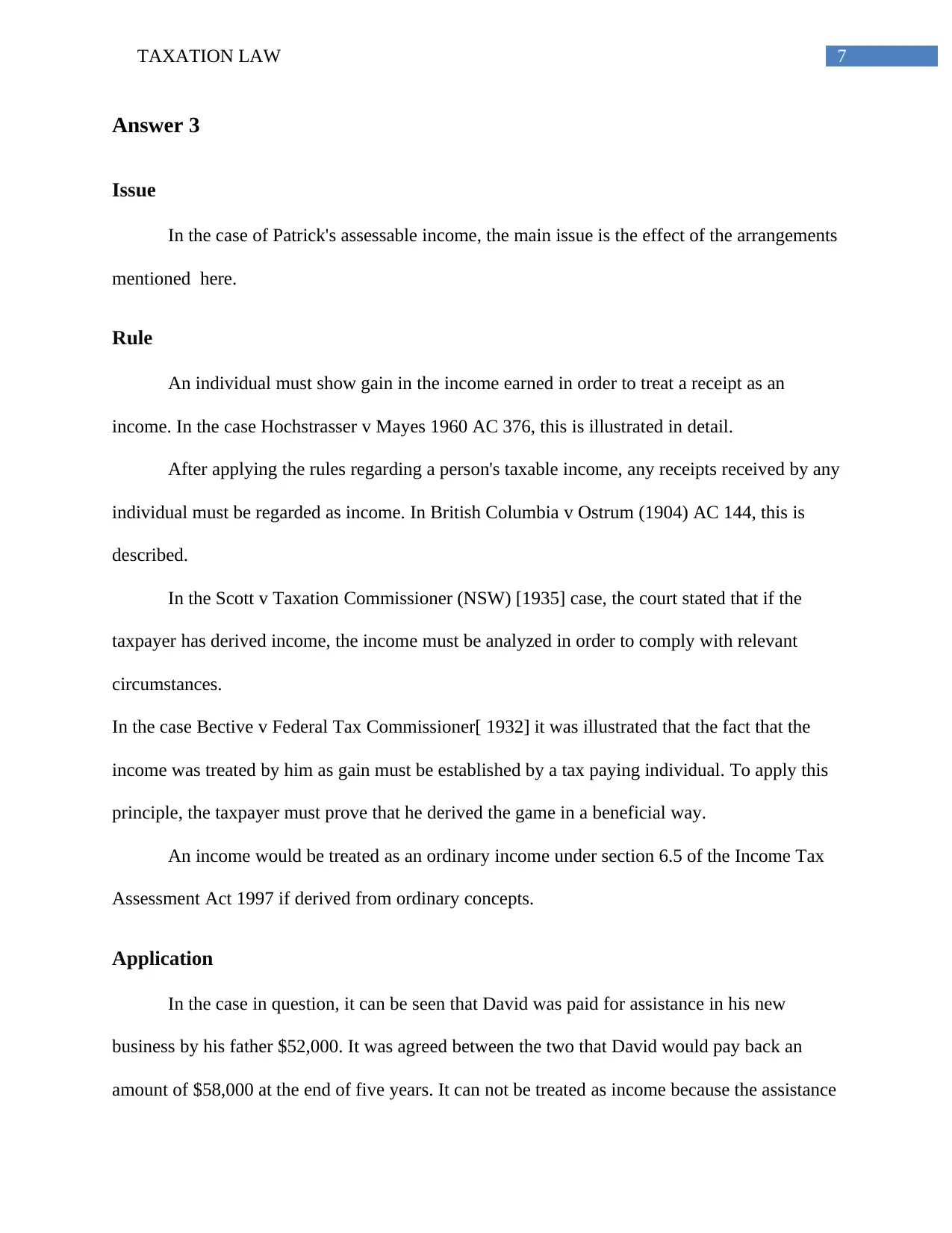
7TAXATION LAW
Answer 3
Issue
In the case of Patrick's assessable income, the main issue is the effect of the arrangements
mentioned here.
Rule
An individual must show gain in the income earned in order to treat a receipt as an
income. In the case Hochstrasser v Mayes 1960 AC 376, this is illustrated in detail.
After applying the rules regarding a person's taxable income, any receipts received by any
individual must be regarded as income. In British Columbia v Ostrum (1904) AC 144, this is
described.
In the Scott v Taxation Commissioner (NSW) [1935] case, the court stated that if the
taxpayer has derived income, the income must be analyzed in order to comply with relevant
circumstances.
In the case Bective v Federal Tax Commissioner[ 1932] it was illustrated that the fact that the
income was treated by him as gain must be established by a tax paying individual. To apply this
principle, the taxpayer must prove that he derived the game in a beneficial way.
An income would be treated as an ordinary income under section 6.5 of the Income Tax
Assessment Act 1997 if derived from ordinary concepts.
Application
In the case in question, it can be seen that David was paid for assistance in his new
business by his father $52,000. It was agreed between the two that David would pay back an
amount of $58,000 at the end of five years. It can not be treated as income because the assistance
Answer 3
Issue
In the case of Patrick's assessable income, the main issue is the effect of the arrangements
mentioned here.
Rule
An individual must show gain in the income earned in order to treat a receipt as an
income. In the case Hochstrasser v Mayes 1960 AC 376, this is illustrated in detail.
After applying the rules regarding a person's taxable income, any receipts received by any
individual must be regarded as income. In British Columbia v Ostrum (1904) AC 144, this is
described.
In the Scott v Taxation Commissioner (NSW) [1935] case, the court stated that if the
taxpayer has derived income, the income must be analyzed in order to comply with relevant
circumstances.
In the case Bective v Federal Tax Commissioner[ 1932] it was illustrated that the fact that the
income was treated by him as gain must be established by a tax paying individual. To apply this
principle, the taxpayer must prove that he derived the game in a beneficial way.
An income would be treated as an ordinary income under section 6.5 of the Income Tax
Assessment Act 1997 if derived from ordinary concepts.
Application
In the case in question, it can be seen that David was paid for assistance in his new
business by his father $52,000. It was agreed between the two that David would pay back an
amount of $58,000 at the end of five years. It can not be treated as income because the assistance
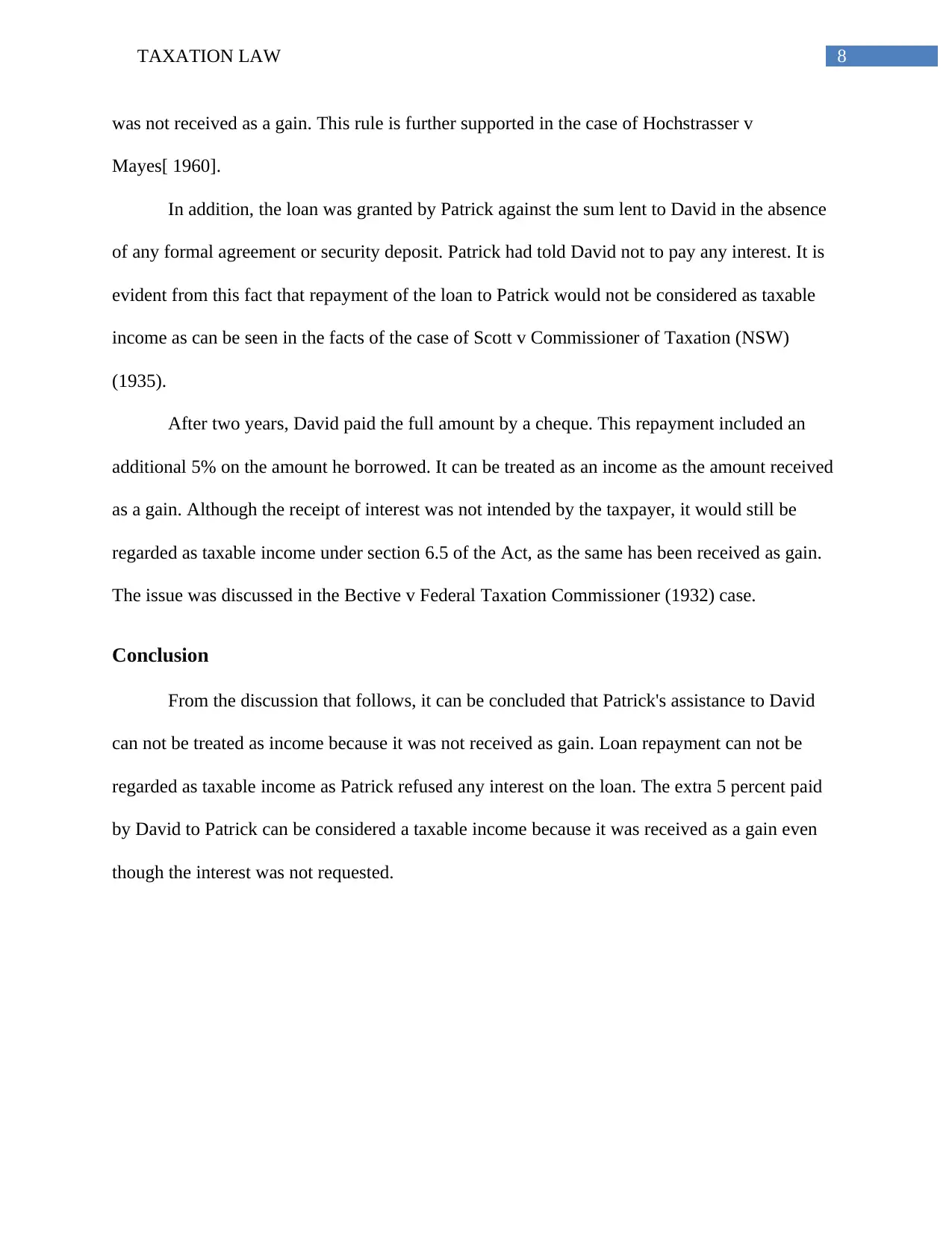
8TAXATION LAW
was not received as a gain. This rule is further supported in the case of Hochstrasser v
Mayes[ 1960].
In addition, the loan was granted by Patrick against the sum lent to David in the absence
of any formal agreement or security deposit. Patrick had told David not to pay any interest. It is
evident from this fact that repayment of the loan to Patrick would not be considered as taxable
income as can be seen in the facts of the case of Scott v Commissioner of Taxation (NSW)
(1935).
After two years, David paid the full amount by a cheque. This repayment included an
additional 5% on the amount he borrowed. It can be treated as an income as the amount received
as a gain. Although the receipt of interest was not intended by the taxpayer, it would still be
regarded as taxable income under section 6.5 of the Act, as the same has been received as gain.
The issue was discussed in the Bective v Federal Taxation Commissioner (1932) case.
Conclusion
From the discussion that follows, it can be concluded that Patrick's assistance to David
can not be treated as income because it was not received as gain. Loan repayment can not be
regarded as taxable income as Patrick refused any interest on the loan. The extra 5 percent paid
by David to Patrick can be considered a taxable income because it was received as a gain even
though the interest was not requested.
was not received as a gain. This rule is further supported in the case of Hochstrasser v
Mayes[ 1960].
In addition, the loan was granted by Patrick against the sum lent to David in the absence
of any formal agreement or security deposit. Patrick had told David not to pay any interest. It is
evident from this fact that repayment of the loan to Patrick would not be considered as taxable
income as can be seen in the facts of the case of Scott v Commissioner of Taxation (NSW)
(1935).
After two years, David paid the full amount by a cheque. This repayment included an
additional 5% on the amount he borrowed. It can be treated as an income as the amount received
as a gain. Although the receipt of interest was not intended by the taxpayer, it would still be
regarded as taxable income under section 6.5 of the Act, as the same has been received as gain.
The issue was discussed in the Bective v Federal Taxation Commissioner (1932) case.
Conclusion
From the discussion that follows, it can be concluded that Patrick's assistance to David
can not be treated as income because it was not received as gain. Loan repayment can not be
regarded as taxable income as Patrick refused any interest on the loan. The extra 5 percent paid
by David to Patrick can be considered a taxable income because it was received as a gain even
though the interest was not requested.
⊘ This is a preview!⊘
Do you want full access?
Subscribe today to unlock all pages.

Trusted by 1+ million students worldwide
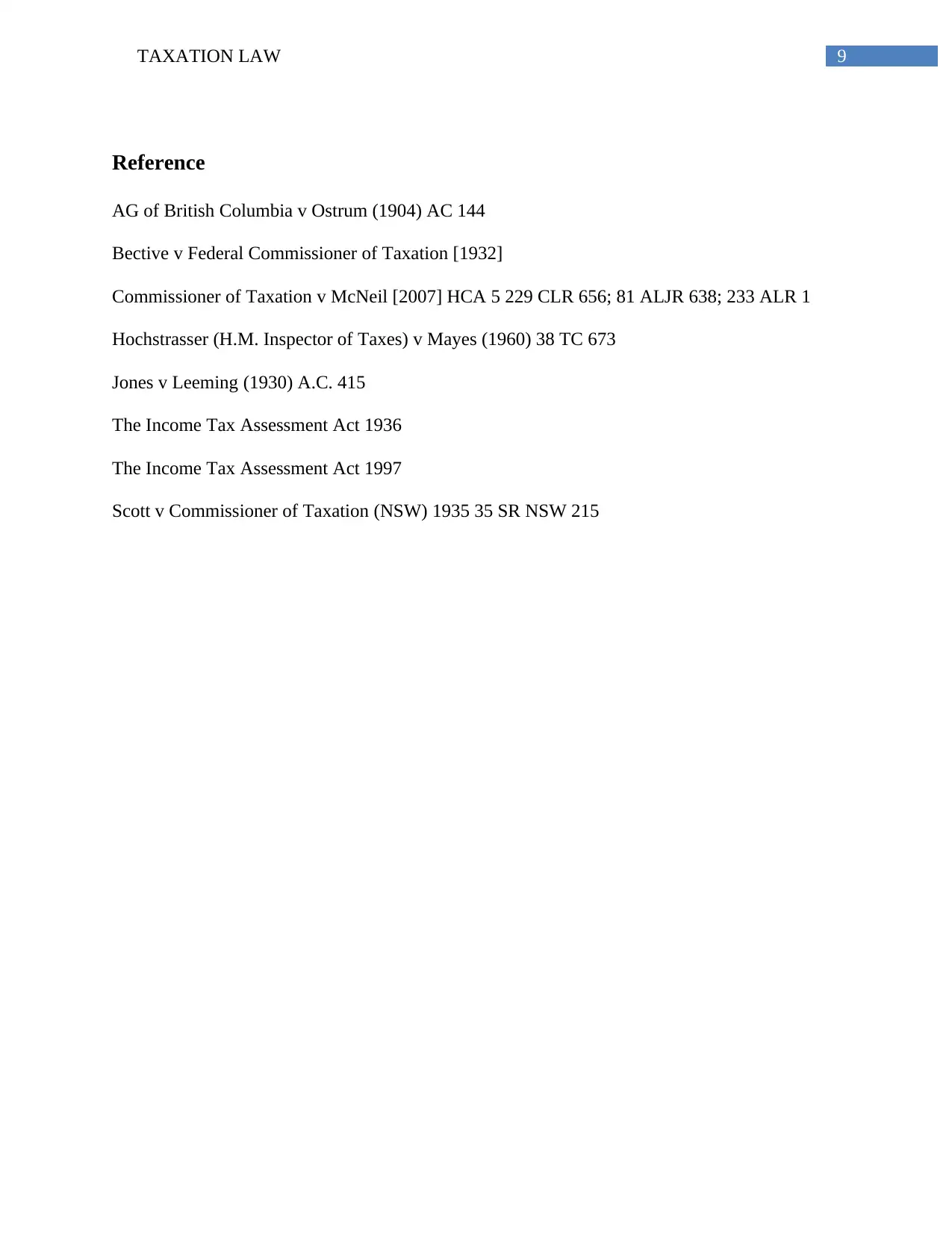
9TAXATION LAW
Reference
AG of British Columbia v Ostrum (1904) AC 144
Bective v Federal Commissioner of Taxation [1932]
Commissioner of Taxation v McNeil [2007] HCA 5 229 CLR 656; 81 ALJR 638; 233 ALR 1
Hochstrasser (H.M. Inspector of Taxes) v Mayes (1960) 38 TC 673
Jones v Leeming (1930) A.C. 415
The Income Tax Assessment Act 1936
The Income Tax Assessment Act 1997
Scott v Commissioner of Taxation (NSW) 1935 35 SR NSW 215
Reference
AG of British Columbia v Ostrum (1904) AC 144
Bective v Federal Commissioner of Taxation [1932]
Commissioner of Taxation v McNeil [2007] HCA 5 229 CLR 656; 81 ALJR 638; 233 ALR 1
Hochstrasser (H.M. Inspector of Taxes) v Mayes (1960) 38 TC 673
Jones v Leeming (1930) A.C. 415
The Income Tax Assessment Act 1936
The Income Tax Assessment Act 1997
Scott v Commissioner of Taxation (NSW) 1935 35 SR NSW 215
1 out of 10
Related Documents
Your All-in-One AI-Powered Toolkit for Academic Success.
+13062052269
info@desklib.com
Available 24*7 on WhatsApp / Email
![[object Object]](/_next/static/media/star-bottom.7253800d.svg)
Unlock your academic potential
Copyright © 2020–2025 A2Z Services. All Rights Reserved. Developed and managed by ZUCOL.




